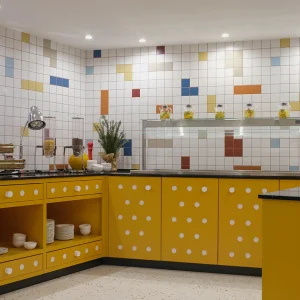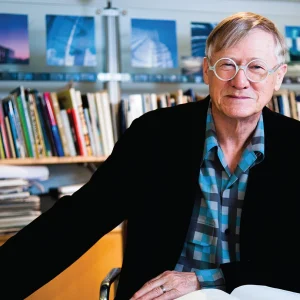
Main picture: Temporary Uses, Bicycle Routes and Container Cafe Kalasatama.Photo: Teina Ryynänen,City of Helsinki Media Bank
An elegant cluster of small wooden pyramids will land in the canal by King’s Cross Station this month. The Floating Viewpoint has been commissioned by the London Wildlife Trust to engage Londoners with a little-known twoacre chunk of greenery, the Camley Street Natural Park, at the back of Central St Martins’ glossy new Granary building.

Kalasatama Urban Gardening. Photo: Pasi Autio, City of Helsinki Media Bank
In a joint competition organised by The Architecture Foundation, three young Finnish architects – none of them quite finished with their studies at Helsinki’s Aaalto University – have been given a chance to create a little haven and wildlife-spotting lookout right in the heart of London (the scheme was previewed in FX July). The trio are well aware of how lucky they are. ‘Not many architects get to build a project in central London before they have even qualified,’ agrees Erkko Aarti, one of the three.
A flying visit to Finland quickly clarifies the inspiration for Aarti, and his colleagues Arto Ollila and Mikki Ristola. The country’s coastline is peppered with thousands of small islands which have clearly had a role in inspiring their Floating Viewpoint project, not just in the jutting shapes of its pyramid pods (very similar to the strangely conical boulders that often protrude from the water around the islands) but also in the spirit of its conception: there is a tradition among many urban Fins of retreating to these islands – usually to a simple wooden summer house – during the warmer months, taking a restorative break from urban life and getting back to nature. Even though many of the islands are privately owned, all Fins apparently have rights to step ashore on them, have a picnic, or even camp out, as long as it’s a respectful distance from the main dwelling.

Grow bags stuffed with homegrown vegetables, fruit and herbs now populate the dock areas of Helsinki in a boom in urban farming
These ‘everyman’s rights’ as well as the tradition of seasonal retreat are undoubtedly part of what breeds a deep sense of attachment to the land and to nature among the Fins. But it could be easy to see that as a culturally specific phenomenon – after all, with only five million inhabitants (about the population of Scotland) inhabiting a country just a tad smaller than Germany, land resources are not scarce. Overcrowding is hardly the major issue that it is for Londoners, Parisians or Manhattanites. Which makes it all the more delightful that this little piece of entitlement – a space where anyone can sit, learn about and observe the surrounding wildlife – is being created in the heart of one of the world’s most frenetic and fiercely territorial cities.

Kalasatama Active Senior Citizens Marketing co-housing community, Kotisatama. Photo: Pasi Autio, City of Helsinki Media Bank
There are vast swathes of London that the population at large doesn’t feel entitled to enter, whether it’s the urban badlands of the worst housing estates or the gated apartment buildings of Russian oligarchs in Chelsea Harbour. And as the UK’s capital is once again bristling with cranes constructing high-rise apartment blocks, the choicest of which will be sold off to rich investors in China, Malaysia and the Middle East, the local authorities responsible would do well to look at the care and consideration that Helsinki is giving to its own resident population while engaging in an even bigger regeneration project.
Helsinki’s former industrial ports – more than half a square mile – are being redeveloped as new residential neighbourhoods, in a piece of ‘slow’ regeneration that will evolve over 30 years. In order to get it right, a major programme of consultation has been going on, fuelled by social media and a proactive city-planning department, willing to grant multiple leases for temporary uses, so that the shape of citizen’s own desires and interests can be painted on to the urban landscape.
Thanks to this civic generosity, it seems Helsinki-ites are rediscovering the Nordic tradition of ‘talkoot’ – ‘community effort’. As Helsinki designer and blogger Hella Hernberg writes in her charming book, Helsinki, Beyond Dreams, Talkoot is when ‘people who barely know each other get together and help build something like a barn, a sauna, or an oven – out of nothing’. A community oven as well as a sauna have indeed already been constructed in the Kalasatama area of the city centre, where music, cycling and food festivals are rapidly multiplying. A boom in urban farming has also resulted: hundreds of grow bags now squat on the vast concrete dockyards, providing vegetables, herbs and fruit for Helsinki food lovers and families throughout the summer.
Helsinki is not alone in this flourishing of grass-roots urban engagement. But it seems to be doing it more comprehensively and with greater generosity than any other city I’ve come across. Perhaps it can afford to be generous, as one of few EU countries with a healthy economy. But, just as the Floating Viewpoint will hopefully become a reminder for frenetic Londoners of the life-enhancing assets on their own doorstep, maybe the Fins’ inclusive and considerate approach to regeneration can serve as a beacon for those currently redrawing the urban landscapes of the world’s major cities. As John Comber, the deputy chief executive for regeneration at Greenwich admitted at a recent NLA conference: ‘Regeneration is not about buildings, it’s about people.’





